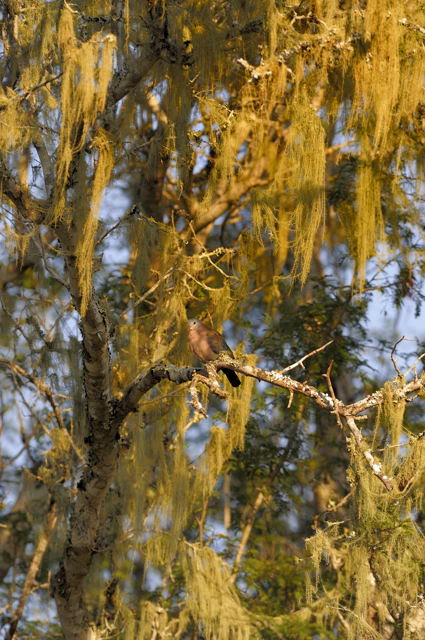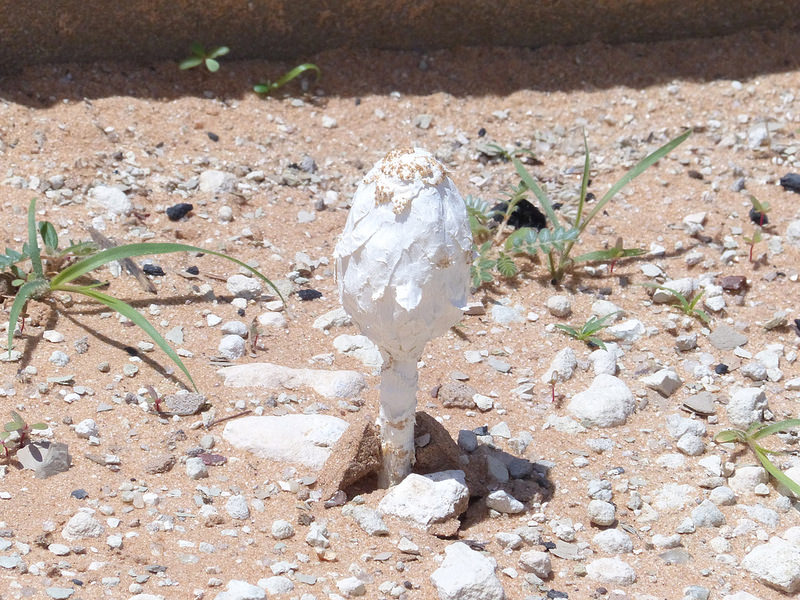Index to Funghi
Order: Agaricales (Common Gilled Mushrooms and Allies)
Family Agaricaceae (Field Mushrooms, Puffballs, and Allies)
Podaxis sp. Termite Inkcap viewtopic.php?p=528708#p528708
Order: Boletales
Family: Boletinellaceae
Phlebopus sudanicus Bushveld Bolete viewtopic.php?p=530930#p530930
Order: Lecanorales (Lichen-forming Fungi)
Family: Parmeliaceae (Lichen-forming fungi in symbiotic association with a green alga)
Usnea barbata Old Man's Beard viewtopic.php?f=248&t=3789&p=4100#p172051
Order: Polyporales (Shelf Fungi)
Family: Polyporaceae (Bracket Fungi)
Trametes sanguinea Cinnabar Bracket viewtopic.php?p=528738#p528738
Trametes versicolor Turkey-Tail viewtopic.php?p=528752#p528752
Africa Wild Funghi Book
Moderator: Klipspringer
Africa Wild Funghi Book
Old Man's Beard Usnea barbata
Order: Lecanorales. Family: Parmeliaceae

Tembe Masizwane Lodge. KwaZulu-Natal.
Description
A greenish coloured lichen that has a symbiotic relationship with a type of alga (Chlorophyta). It grows by hanging from tree branches and resembles hair, hence the common name.
As with most lichens, it is very susceptible to air pollution which restricts growth or, in severerly polluted air, kills it.
Usnea lichens have medicinal properties and have been used as wound dressings and also to help fight off infections.
Order: Lecanorales. Family: Parmeliaceae

Tembe Masizwane Lodge. KwaZulu-Natal.
Description
A greenish coloured lichen that has a symbiotic relationship with a type of alga (Chlorophyta). It grows by hanging from tree branches and resembles hair, hence the common name.
As with most lichens, it is very susceptible to air pollution which restricts growth or, in severerly polluted air, kills it.
Usnea lichens have medicinal properties and have been used as wound dressings and also to help fight off infections.
-
Klipspringer
- Global Moderator
- Posts: 5858
- Joined: Sat Sep 14, 2013 12:34 pm
- Country: Germany
- Contact:
Re: Africa Wild Funghi Book
Termite Inkcap Podaxis sp.
Order: Agaricales. Family: Agaricaceae

Kgalagadi Transfrontier Park at Samevloeiing © GavinW
Immature Podaxis fruiting bodies growing on a termite mound, Pilanesberg (Korwe loop) © Amoli
The fungal genus Podaxis (Agaricaceae) is frequently found on mounds of the grass-cutting termite genus Trinervitermes (Family: Termitidae, subfamily: Nasutitermitinae) in Africa. Some species of Podaxis are adapted to desert living and to not associate with termites.
Trinervitermes are distributed in savannah and grassland ecosystems throughout the paleotropics and their dome-shaped mounds are a common sight in Southern Africa. Closed to the exterior environment and only accessible for the termites through subterranean tunnels, the mounds maintain a relatively stable interior temperature and humidity throughout the day. The centralised nature of termite colonies concentrates nutrients within and around the nest. In Trinervitermes, a large proportion of this nutrient deposition happens in faeces-lined grass-storage chambers. Complemented by the removal of soil from deep under ground, this should lead to increased levels of biodiversity in association with termite mounds compared to the surrounding savannah. However, aside from Podaxis, no other fungi or plants have, to our knowledge, been reported to grow from the mounds of Nasutitermitinae.
Podaxis fruiting bodies, occurring on Trinervitermes mounds, originate from the grass-storage chambers. It is unknown whether the termites feed on the fungus but it is also possible that Podaxis uses the favourable conditions and concentrated nutrients within the nest to grow as a commensal without affecting the termites, or as a parasite growing inside the nest to the detriment of the colony.
Links:
https://www.sciencedirect.com/science/a ... 4616300617
Order: Agaricales. Family: Agaricaceae

Kgalagadi Transfrontier Park at Samevloeiing © GavinW
Immature Podaxis fruiting bodies growing on a termite mound, Pilanesberg (Korwe loop) © Amoli
The fungal genus Podaxis (Agaricaceae) is frequently found on mounds of the grass-cutting termite genus Trinervitermes (Family: Termitidae, subfamily: Nasutitermitinae) in Africa. Some species of Podaxis are adapted to desert living and to not associate with termites.
Trinervitermes are distributed in savannah and grassland ecosystems throughout the paleotropics and their dome-shaped mounds are a common sight in Southern Africa. Closed to the exterior environment and only accessible for the termites through subterranean tunnels, the mounds maintain a relatively stable interior temperature and humidity throughout the day. The centralised nature of termite colonies concentrates nutrients within and around the nest. In Trinervitermes, a large proportion of this nutrient deposition happens in faeces-lined grass-storage chambers. Complemented by the removal of soil from deep under ground, this should lead to increased levels of biodiversity in association with termite mounds compared to the surrounding savannah. However, aside from Podaxis, no other fungi or plants have, to our knowledge, been reported to grow from the mounds of Nasutitermitinae.
Podaxis fruiting bodies, occurring on Trinervitermes mounds, originate from the grass-storage chambers. It is unknown whether the termites feed on the fungus but it is also possible that Podaxis uses the favourable conditions and concentrated nutrients within the nest to grow as a commensal without affecting the termites, or as a parasite growing inside the nest to the detriment of the colony.
Links:
https://www.sciencedirect.com/science/a ... 4616300617
-
Klipspringer
- Global Moderator
- Posts: 5858
- Joined: Sat Sep 14, 2013 12:34 pm
- Country: Germany
- Contact:
Re: Africa Wild Funghi Book
Cinnabar Bracket Trametes sanguinea (previously named Pycnoporus sanguineus).
Order Polyporales. Family Polyporaceae
Woodville Big Tree Forest Trail, Wilderness, Garden Route © All-Nature
Description
Occurs on dead wood of broad-leaved trees and pine trees, often in exposed positions. Fruit bodies appear singly, grouped or clustered and have sessile substrate attachment.
Cap: Tough, leathery to rigid, fan- to bracket- to kidney-shaped to circular, can fuse laterally or overlap, bright red-orange; narrowly attached to wood or bark, can appear to have short stipe; margin thin, even, velvety; upper surface velvety turning smooth, shiny, with lighter zones, fading to grey or dirty white.
Hymenial surface: Same colour as surface but darker, velvety; pores minute, circular to angular.
Flesh: Thin, same colour as surface, zoned, tough, felty; no odour.
Spore print: White
Edibility: Inedible - tough and not palatable.
Distribution
Tropical or subtropical regions of the world.
Order Polyporales. Family Polyporaceae
Woodville Big Tree Forest Trail, Wilderness, Garden Route © All-Nature
Description
Occurs on dead wood of broad-leaved trees and pine trees, often in exposed positions. Fruit bodies appear singly, grouped or clustered and have sessile substrate attachment.
Cap: Tough, leathery to rigid, fan- to bracket- to kidney-shaped to circular, can fuse laterally or overlap, bright red-orange; narrowly attached to wood or bark, can appear to have short stipe; margin thin, even, velvety; upper surface velvety turning smooth, shiny, with lighter zones, fading to grey or dirty white.
Hymenial surface: Same colour as surface but darker, velvety; pores minute, circular to angular.
Flesh: Thin, same colour as surface, zoned, tough, felty; no odour.
Spore print: White
Edibility: Inedible - tough and not palatable.
Distribution
Tropical or subtropical regions of the world.
-
Klipspringer
- Global Moderator
- Posts: 5858
- Joined: Sat Sep 14, 2013 12:34 pm
- Country: Germany
- Contact:
Re: Africa Wild Funghi Book
Turkey-Tail Trametes versicolor
Order Polyporales. Family Polyporaceae
Woodville Big Tree Forest Trail, Wilderness, Garden Route © All-Nature
The name comes from the resemblance of the fruiting body to a wild Turkey’s Tail.
Description
This species can be recognised by the silky cap, lobed margin edge and multicoloured concentric zones on the upper surface.
Cap: 2–7cm in diameter, 2–5cm radius, 0.1–0.2cm thick; tough, fibrous, thin; sessile or narrowly attached with a reduced base, often growing together laterally or arranged in overlapping tiers or forming rosettes; semicircular, fanto kidney- to bracket-shaped; margin wavy; upper surface velvety; concentric zones of cream, orange and brown, sometimes also blue, black, grey and green, margin usually white to cream.
Lower surface: pore mouths fine but visible, 30–60 per cm; white to cream; tubes 0.05–0.10cm deep.
Flesh: tough, cottony, leathery; white to pale cream.
Smell: faint, pleasant, mushroomy to slightly fishy odour.
Spore print: white to straw-yellow.
Edibility: Inedible; too tough to eat.
Distribution
Widespread in South Africa. Occurs worldwide; large global distribution.
Habitat
Grows on dead or decaying trunks, stumps or branches of broadleaved trees; fruit bodies grouped, compound, sometimes in rosette formation.
Medicinal
Trametes versicolor has antibacterial, antioxidant and antiviral properties, and is known to reduce cholesterol levels. It is also well known for its use in treating breast cancer. A tea made of dried T. versicolor is believed to have a beneficial impact on the immune system.
The mushroom is relatively easy to cultivate, but since they grow in such abundance in the wild, the mushroom is often harvested directly from the forest for medicinal use.
Order Polyporales. Family Polyporaceae
Woodville Big Tree Forest Trail, Wilderness, Garden Route © All-Nature
The name comes from the resemblance of the fruiting body to a wild Turkey’s Tail.
Description
This species can be recognised by the silky cap, lobed margin edge and multicoloured concentric zones on the upper surface.
Cap: 2–7cm in diameter, 2–5cm radius, 0.1–0.2cm thick; tough, fibrous, thin; sessile or narrowly attached with a reduced base, often growing together laterally or arranged in overlapping tiers or forming rosettes; semicircular, fanto kidney- to bracket-shaped; margin wavy; upper surface velvety; concentric zones of cream, orange and brown, sometimes also blue, black, grey and green, margin usually white to cream.
Lower surface: pore mouths fine but visible, 30–60 per cm; white to cream; tubes 0.05–0.10cm deep.
Flesh: tough, cottony, leathery; white to pale cream.
Smell: faint, pleasant, mushroomy to slightly fishy odour.
Spore print: white to straw-yellow.
Edibility: Inedible; too tough to eat.
Distribution
Widespread in South Africa. Occurs worldwide; large global distribution.
Habitat
Grows on dead or decaying trunks, stumps or branches of broadleaved trees; fruit bodies grouped, compound, sometimes in rosette formation.
Medicinal
Trametes versicolor has antibacterial, antioxidant and antiviral properties, and is known to reduce cholesterol levels. It is also well known for its use in treating breast cancer. A tea made of dried T. versicolor is believed to have a beneficial impact on the immune system.
The mushroom is relatively easy to cultivate, but since they grow in such abundance in the wild, the mushroom is often harvested directly from the forest for medicinal use.
-
Klipspringer
- Global Moderator
- Posts: 5858
- Joined: Sat Sep 14, 2013 12:34 pm
- Country: Germany
- Contact:
Re: Africa Wild Funghi Book
Bushveld Bolete Phlebopus sudanicus, Phaeogyroporus sudanicus
Order Boletales. Family Boletinellaceae
Kruger National Park, Skukuza (Nov 2012) © BluTuna
Description
Cap: 8–55 cm in diameter. Reddish to ochrebrown; dry and smooth, becoming cracked. Convex, often unequally expanded.
Stem: 6–27 cm long, 4–9 cm wide; same colour as cap; large, firm, solid; attached off-centre of the cap. Base swollen, with a tuft of mycelium.
Ring: absent
Tubes: Very close, 9–30 mm deep; greenish-yellow, darkening with age.
Flesh: Thick, firm, white becoming brownish, stains bluish-green when cut. Pleasant odour.
Spores: Olive-brown.
Edibility: Suspect. The flavour is mild and uninteresting. It is not recommended because it has been reported, from tropical Africa, to cause intoxication. It should be noted that the poor digestibility of species of the genus Phlebopus obliges consumers to boil them.
Distribution
Common throughout tropical Africa and occasionally occurs in central and northern South Africa.
Habitat
Grows in open grassland and under indigenous broad-leaved trees.
Order Boletales. Family Boletinellaceae
Kruger National Park, Skukuza (Nov 2012) © BluTuna
Description
Cap: 8–55 cm in diameter. Reddish to ochrebrown; dry and smooth, becoming cracked. Convex, often unequally expanded.
Stem: 6–27 cm long, 4–9 cm wide; same colour as cap; large, firm, solid; attached off-centre of the cap. Base swollen, with a tuft of mycelium.
Ring: absent
Tubes: Very close, 9–30 mm deep; greenish-yellow, darkening with age.
Flesh: Thick, firm, white becoming brownish, stains bluish-green when cut. Pleasant odour.
Spores: Olive-brown.
Edibility: Suspect. The flavour is mild and uninteresting. It is not recommended because it has been reported, from tropical Africa, to cause intoxication. It should be noted that the poor digestibility of species of the genus Phlebopus obliges consumers to boil them.
Distribution
Common throughout tropical Africa and occasionally occurs in central and northern South Africa.
Habitat
Grows in open grassland and under indigenous broad-leaved trees.


